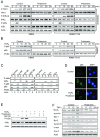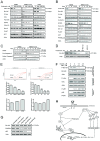Pristimerin induces apoptosis in imatinib-resistant chronic myelogenous leukemia cells harboring T315I mutation by blocking NF-kappaB signaling and depleting Bcr-Abl
- PMID: 20482842
- PMCID: PMC2893099
- DOI: 10.1186/1476-4598-9-112
Pristimerin induces apoptosis in imatinib-resistant chronic myelogenous leukemia cells harboring T315I mutation by blocking NF-kappaB signaling and depleting Bcr-Abl
Erratum in
-
Correction to: Pristimerin induces apoptosis in imatinib-resistant chronic myelogenous leukemia cells harboring T315I mutation by blocking NF-κB signaling and depleting Bcr-Abl.Mol Cancer. 2021 Dec 31;20(1):172. doi: 10.1186/s12943-021-01414-7. Mol Cancer. 2021. PMID: 34969396 Free PMC article. No abstract available.
Abstract
Background: Chronic myelogenous leukemia (CML) is characterized by the chimeric tyrosine kinase Bcr-Abl. Bcr-Abl-T315I is the notorious point mutation that causes resistance to imatinib and the second generation tyrosine kinase inhibitors, leading to poor prognosis. CML blasts have constitutive p65 (RelA NF-kappaB) transcriptional activity, and NF-kappaB may be a potential target for molecular therapies in CML that may also be effective against CML cells with Bcr-Abl-T315I.
Results: In this report, we discovered that pristimerin, a quinonemethide triterpenoid isolated from Celastraceae and Hippocrateaceae, inhibited growth and induced apoptosis in CML cells, including the cells harboring Bcr-Abl-T315I mutation. Additionally, pristimerin inhibited the growth of imatinib-resistant Bcr-Abl-T315I xenografts in nude mice. Pristimerin blocked the TNFalpha-induced IkappaBalpha phosphorylation, translocation of p65, and expression of NF-kappaB-regulated genes. Pristimerin inhibited two steps in NF-kappaB signaling: TAK1TauIKK and IKKTauIkappaBalpha. Pristimerin potently inhibited two pairs of CML cell lines (KBM5 versus KBM5-T315I, 32D-Bcr-Abl versus 32D-Bcr-Abl-T315I) and primary cells from a CML patient with acquired resistance to imatinib. The mRNA and protein levels of Bcr-Abl in imatinib-sensitive (KBM5) or imatinib-resistant (KBM5-T315I) CML cells were reduced after pristimerin treatment. Further, inactivation of Bcr-Abl by imatinib pretreatment did not abrogate the TNFalpha-induced NF-kappaB activation while silencing p65 by siRNA did not affect the levels of Bcr-Abl, both results together indicating that NF-kappaB inactivation and Bcr-Abl inhibition may be parallel independent pathways.
Conclusion: To our knowledge, this is the first report to show that pristimerin is effective in vitro and in vivo against CML cells, including those with the T315I mutation. The mechanisms may involve inhibition of NF-kappaB and Bcr-Abl. We concluded that pristimerin could be a lead compound for further drug development to overcome imatinib resistance in CML patients.
Figures







Similar articles
-
Triptolide inhibits Bcr-Abl transcription and induces apoptosis in STI571-resistant chronic myelogenous leukemia cells harboring T315I mutation.Clin Cancer Res. 2009 Mar 1;15(5):1686-97. doi: 10.1158/1078-0432.CCR-08-2141. Epub 2009 Feb 24. Clin Cancer Res. 2009. PMID: 19240172
-
Gambogic acid induces apoptosis in imatinib-resistant chronic myeloid leukemia cells via inducing proteasome inhibition and caspase-dependent Bcr-Abl downregulation.Clin Cancer Res. 2014 Jan 1;20(1):151-63. doi: 10.1158/1078-0432.CCR-13-1063. Epub 2013 Dec 12. Clin Cancer Res. 2014. PMID: 24334603 Free PMC article.
-
Celastrol, a novel HSP90 inhibitor, depletes Bcr-Abl and induces apoptosis in imatinib-resistant chronic myelogenous leukemia cells harboring T315I mutation.Cancer Lett. 2010 Apr 28;290(2):182-91. doi: 10.1016/j.canlet.2009.09.006. Epub 2009 Oct 12. Cancer Lett. 2010. PMID: 19819619
-
New Bcr-Abl inhibitors in chronic myeloid leukemia: keeping resistance in check.Expert Opin Investig Drugs. 2008 Jun;17(6):865-78. doi: 10.1517/13543784.17.6.865. Expert Opin Investig Drugs. 2008. PMID: 18491988 Review.
-
Characterization of cancer stem cells in chronic myeloid leukaemia.Biochem Soc Trans. 2007 Nov;35(Pt 5):1347-51. doi: 10.1042/BST0351347. Biochem Soc Trans. 2007. PMID: 17956348 Review.
Cited by
-
lncRNA-PLACT1 sustains activation of NF-κB pathway through a positive feedback loop with IκBα/E2F1 axis in pancreatic cancer.Mol Cancer. 2020 Feb 21;19(1):35. doi: 10.1186/s12943-020-01153-1. Mol Cancer. 2020. PMID: 32085715 Free PMC article.
-
Inhibition of hTERT/telomerase contributes to the antitumor activity of pristimerin in pancreatic ductal adenocarcinoma cells.Oncol Rep. 2015 Jul;34(1):518-24. doi: 10.3892/or.2015.3989. Epub 2015 May 19. Oncol Rep. 2015. PMID: 25997419 Free PMC article.
-
Inhibition of Ras-mediated signaling pathways in CML stem cells.Cell Oncol (Dordr). 2015 Dec;38(6):407-18. doi: 10.1007/s13402-015-0248-2. Epub 2015 Oct 12. Cell Oncol (Dordr). 2015. PMID: 26458816 Review.
-
Antitumor effects of pristimerin on human osteosarcoma cells in vitro and in vivo.Onco Targets Ther. 2017 Nov 28;10:5703-5710. doi: 10.2147/OTT.S150071. eCollection 2017. Onco Targets Ther. 2017. PMID: 29238202 Free PMC article.
-
Adaptor protein Abelson interactor 1 in homeostasis and disease.Cell Commun Signal. 2024 Oct 1;22(1):468. doi: 10.1186/s12964-024-01738-z. Cell Commun Signal. 2024. PMID: 39354505 Free PMC article. Review.
References
Publication types
MeSH terms
Substances
LinkOut - more resources
Full Text Sources
Other Literature Sources
Medical
Molecular Biology Databases
Miscellaneous

